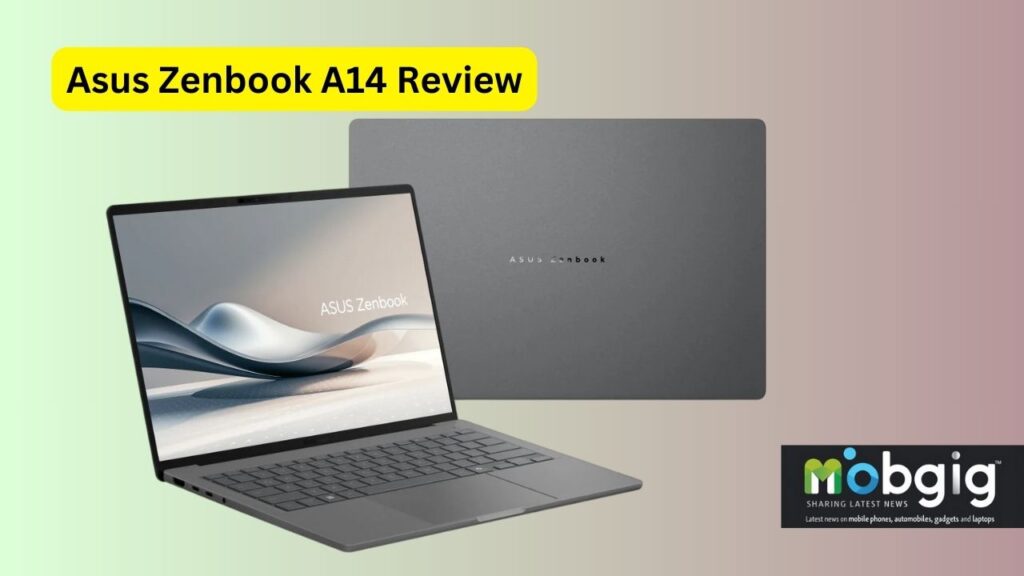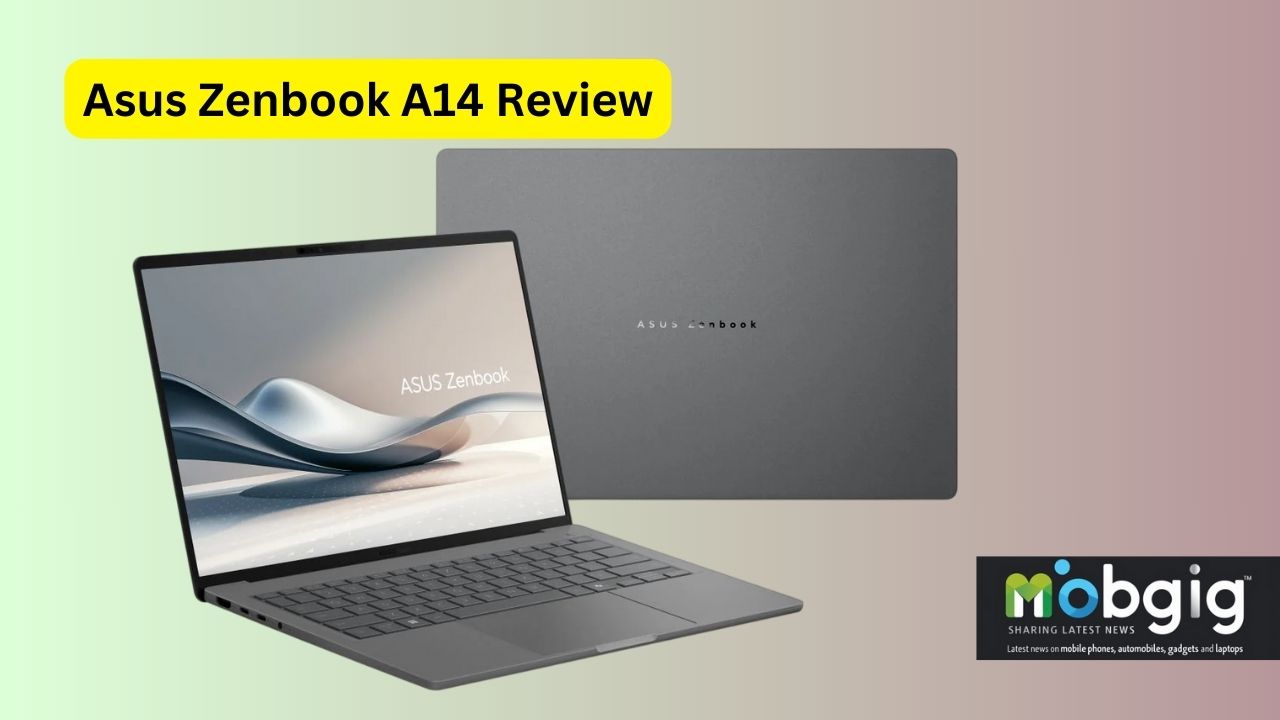Asus Zenbook A14 Review: The Asus Zenbook A14 stands as a direct challenger to Apple’s beloved MacBook Air, sparking intense debates in the laptop world. After spending three weeks testing both machines side by side, I’ve uncovered some surprising findings about their real-world performance.
While the MacBook Air has long been the go-to choice for premium ultraportables, the Zenbook A14 brings some compelling advantages to the table. From its Ceraluminum build to its AI-powered features, this laptop demands attention. Let’s dive into my hands-on comparison to help you decide which machine truly deserves your investment.

Design and Build Quality Face-Off
Initially, what catches your attention about the Zenbook A14 is its innovative construction material. Asus has developed Ceraluminum, a ceramic-aluminum composite that’s 30% lighter and three times stronger than traditional aluminum. The material undergoes rigorous testing, including scratch resistance checks with keys and coins in rotating drums, and shock resistance tests from 50cm heights.
In contrast to the MacBook Air’s conventional aluminum build, the Ceraluminum finish offers a unique tactile experience. The surface feels remarkably like smooth river stone with slight resistance, maintaining a pristine appearance without fingerprint marks. Furthermore, this material covers not just the lid but extends to the palm rest, keyboard deck, and chassis underside.
When it comes to portability, the numbers speak for themselves. The Zenbook A14 weighs just 2.16 pounds, making it notably lighter than the MacBook Air’s 2.7-pound frame. Specifically, the dimensions measure 12.23″ x 8.42″ x 0.53″ at its thinnest point, contributing to its ultra-portable profile.
The display quality presents another significant differentiator. The Zenbook A14 features a 14-inch OLED panel with impressive specifications:
- 1920 x 1200 resolution with 0.2ms response time
- 600 nits HDR peak brightness
- 100% DCI-P3 color gamut
- 1,000,000:1 contrast ratio
Consequently, the visual experience is enhanced by 70% less harmful blue light emission compared to traditional displays. The audio system complements the visual experience with dual super-linear speakers and smart amp technology.
The Zenbook comes in two sophisticated colors: Iceland Gray and Zabriskie Beige. The Iceland Gray variant captures the essence of Nordic mountains, whereas the Zabriskie Beige reflects warm, desert-like tones. Additionally, the laptop meets MIL-STD 810H military standards for durability, ensuring it maintains its premium feel throughout extended use.
The keyboard offers a comfortable 1.3mm key travel, paired with a precision touchpad that matches the premium feel of the chassis. The entire package demonstrates Asus’s attention to detail in creating a device that not only competes with but potentially surpasses the established benchmark in premium ultraportables.
Real-World Performance Battle
Moving beyond esthetics, let’s examine how the Zenbook A14’s Snapdragon X processor performs in real-world scenarios. Generally, this laptop excels at everyday tasks, though with some notable trade-offs against the MacBook Air.
Daily Computing Tasks Comparison
The Snapdragon X processor delivers smooth performance for routine tasks. Indeed, websites load swiftly, and Google Docs remain responsive even during low battery operation. The laptop maintains consistent performance levels whether plugged in or running on battery, making it particularly suitable for long workdays.
Content Creation Capabilities
For creative professionals, the Zenbook A14 presents a mixed bag of capabilities:
- Photo editing: Handles multiple Photoshop projects simultaneously
- Video editing: Supports 4K video editing with some limitations
- RAM management: Projects require closing after 6-7 photo boards
Moreover, the dual-fan cooling system enables the processor to maintain its full 45W TDP during intensive tasks. This results in stronger sustained performance compared to the fanless MacBook Air, particularly during extended workloads.
Gaming and Entertainment Experience
The entertainment capabilities of the Zenbook A14 surpass expectations for an ultraportable device. The 14-inch OLED display produces vivid colors with impressive contrast. Simultaneously, the Harman Kardon tuned speakers with Dolby Atmos support deliver immersive audio.
For gaming enthusiasts, the system demonstrates remarkable versatility:
- Maintains stable frame rates at 1080p resolution
- Operates quietly at approximately 25 DB during intensive sessions
- Supports cloud gaming platforms like GeForce Now and Microsoft Cloud Gaming
The integrated NPU, capable of 45 TOPS, powers AI features such as Windows Studio Effects and background noise reduction. This processing power particularly shines during video calls and creative tasks that leverage AI capabilities.
Despite these capabilities, it’s worth noting that the Snapdragon X processor doesn’t quite match the raw performance of Apple’s M2 or M3 chips. Nevertheless, for most users focusing on productivity tasks, web browsing, and occasional creative work, the performance difference remains largely theoretical rather than practical.
Software Ecosystem Deep Dive
The software ecosystem marks a significant distinction between the Zenbook A14 and its Apple counterpart. Currently, Windows holds over 73% of the operating system market share, notably higher than macOS’s 15%.
Windows on ARM vs macOS
The Zenbook A14 runs exclusively on Windows 11, as the system’s drivers and features are optimized solely for this version. Accordingly, users should note that attempting to install older Windows versions might lead to compatibility issues. The operating system’s performance on ARM architecture has improved substantially, primarily through enhanced emulation capabilities.
App Compatibility Assessment
The software landscape for Windows on ARM in 2024 presents a comprehensive ecosystem. Essential applications available natively include:
- Microsoft Office suite and creative tools like Adobe Photoshop
- Major browsers: Edge, Firefox, Brave, and Chrome
- Entertainment apps: Netflix, Prime Video, Spotify
- Development tools: Visual Studio and Electron framework
The system utilizes binary code translation with resident memory cache, essentially matching Apple’s Rosetta technology in emulation efficiency. Ultimately, when emulated apps interact with Windows APIs, these calls are handled by native code, ensuring smoother performance.
AI Features and Copilot Experience
The Zenbook A14’s AI capabilities set it apart with its 45 TOPS Qualcomm Hexagon NPU. This powerful neural engine enables several innovative features:
- Instant Recall: Searches through documents and emails using natural language descriptions
- Cocreator: Assists in generating and modifying images with AI
- Live Captions: Provides real-time subtitles during video playback
- Windows Studio Effects: Enhances video calls with automatic background blur and lighting improvements
The integration extends beyond basic functionality with Snapdragon Seamless™ technology, subsequently allowing seamless file sharing and screen mirroring between compatible devices. Security remains paramount, featuring Microsoft Pluton security chip and adaptive privacy features that automatically secure sensitive information when users step away.
Battery Life and Efficiency
Battery life stands as a crucial differentiator between these premium ultraportables. The Zenbook A14 packs a substantial 70Wh battery, notably larger than the MacBook Air’s 52.6Wh cell.
Battery Endurance Testing
In controlled testing environments, the Zenbook A14 achieved remarkable results. Essentially, the laptop delivered up to 32 hours of video playback under specific conditions:
- Display brightness at 150 cd/m²
- Wi-Fi disabled
- Keyboard backlight off
- Windows Power Mode in Balance setting
Real-world usage primarily varies based on workload intensity. Even if we consider half of the claimed duration, the Zenbook A14 still offers exceptional untethered computing capabilities.
Charging Speeds Compared
The Zenbook A14’s charging system demonstrates impressive efficiency. The laptop reaches 60% charge in approximately 49 minutes. This quick-charging capability comes through a 65W USB-C power adapter, offering flexibility with:
- Two USB 4 Type-C ports for charging
- Universal input voltage support (100-240V AC)
- Compact adapter design for portability
Power Management Features
Above all, the Zenbook A14 introduces sophisticated power management capabilities. The system includes exclusive battery technology that extends charging cycles from 1000 to 1200 based on rigorous testing.
The MyASUS Battery Health Management system offers customizable options for optimal battery longevity. This feature intelligently maintains the battery at 80% charge until full capacity is needed. The system incorporates:
- Adaptive charging behavior
- Battery health monitoring
- Customizable charging thresholds
- Long-term battery preservation settings
The Snapdragon X processor’s efficiency enables consistent performance whether plugged in or running on battery. This advantage becomes apparent in scenarios requiring sustained performance, as the laptop maintains its capabilities without throttling.
For users concerned about long-term value, the battery management system offers 1.2 times longer battery lifespan compared to standard implementations. The combination of hardware efficiency and software optimization creates a power management ecosystem that balances performance with longevity.
Value and Long-Term Investment
First and foremost, let’s examine the financial aspect of these premium laptops. The Zenbook A14 starts at USD 799.00, offering remarkable value considering its feature set. In essence, this pricing strategy positions it significantly below the MacBook Air’s entry point of USD 1099.00.
Price-to-Performance Analysis
When comparing similarly configured models, the price difference becomes more apparent:
| Configuration | Zenbook A14 | MacBook Air |
| Base Model | USD 799.00 | USD 1099.00 |
| Mid-tier | USD 899.00 | USD 1299.00 |
| High-end | USD 1099.00 | USD 1499.00 |
The Zenbook A14’s performance metrics closely match the MacBook Air in key benchmarks. PCMag testing revealed the Zenbook leading in Geekbench and Cinebench scores, making it a compelling choice for budget-conscious users seeking premium performance.
Future-Proofing Potential
The Zenbook A14 incorporates several forward-looking features that enhance its long-term value:
- Wi-Fi 7 compatibility offering speeds up to 4.8x faster than previous generations
- Battery Health Management system that extends charging cycles from 1000 to 1200
- Digital Product Passport (DPP) initiative supporting eco-friendly practices
As a result of these innovations, the laptop positions itself well for future technological advances. The implementation of Microsoft Pluton security architecture alongside Windows Studio effects demonstrates Asus’s commitment to keeping the device relevant through software updates.
Warranty and Support Comparison
In terms of customer support, Asus maintains a strong position in the industry. The company offers comprehensive warranty coverage and ranks in the top tier for technical support quality. Their phone support demonstrates particular strength, although it’s worth noting that 24/7 availability would be a welcome improvement.
The Digital Product Passport feature stands out as a unique advantage, providing:
- Detailed product specifications
- Complete repair histories
- Comprehensive recycling information
- Carbon footprint data
The laptop’s military-grade durability certification (MIL-STD 810H) further reinforces its long-term reliability. This certification, coupled with the scratch-resistant Ceraluminum construction, suggests reduced maintenance costs over time.
For professionals and students alike, the value proposition extends beyond initial pricing. The combination of AI capabilities through the Qualcomm Hexagon NPU (45 TOPS) and the laptop’s efficient power management system creates a compelling package for long-term use. The system’s ability to maintain performance levels while operating at 45W TDP indicates sustainable performance that won’t degrade significantly over time.
Ultimately, when considering the total cost of ownership, the Zenbook A14’s lower entry price, combined with its durability features and future-proof technologies, presents a strong argument for long-term value. The inclusion of advanced features like passkey support and Windows Studio effects demonstrates Asus’s commitment to keeping the device current through regular software updates and security enhancements.
Conclusion
After extensive testing, the Asus Zenbook A14 stands as a worthy challenger to Apple’s MacBook Air, offering significant advantages that might surprise many users. The innovative Ceraluminum construction certainly sets new standards for durability and lightweight design, while the 32-hour battery life surpasses expectations for an ultraportable device.
Though the Snapdragon X processor doesn’t quite match Apple’s M-series chips in raw performance, the real-world experience remains remarkably smooth for most users. The comprehensive Windows ecosystem, paired with advanced AI capabilities through the 45 TOPS NPU, delivers practical advantages for daily workflows.
The price difference proves particularly compelling – starting at $799 compared to the MacBook Air’s $1,099, the Zenbook A14 offers premium features without the premium price tag. Additionally, future-proof technologies like Wi-Fi 7 compatibility and the Digital Product Passport initiative ensure long-term value.
The laptop excels particularly well for users who prioritize portability, battery life, and value. However, content creators requiring maximum processing power might still prefer the MacBook Air’s M-series capabilities. Undoubtedly, the Zenbook A14 represents a significant step forward in Windows ultraportables, challenging Apple’s dominance with practical innovations rather than mere specifications.

